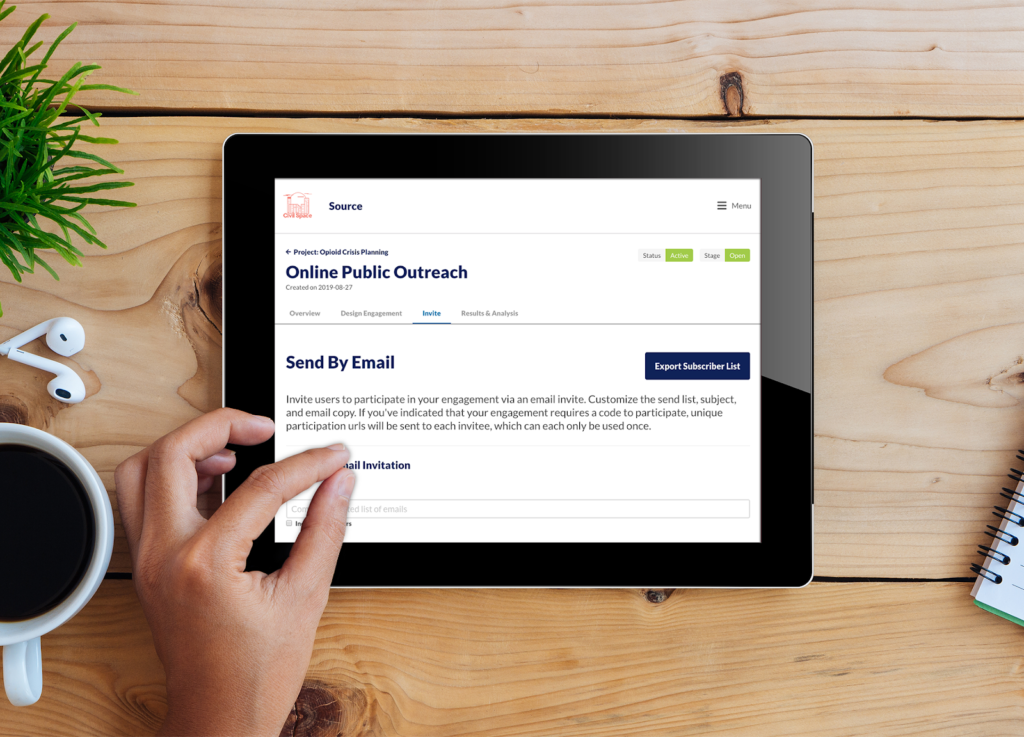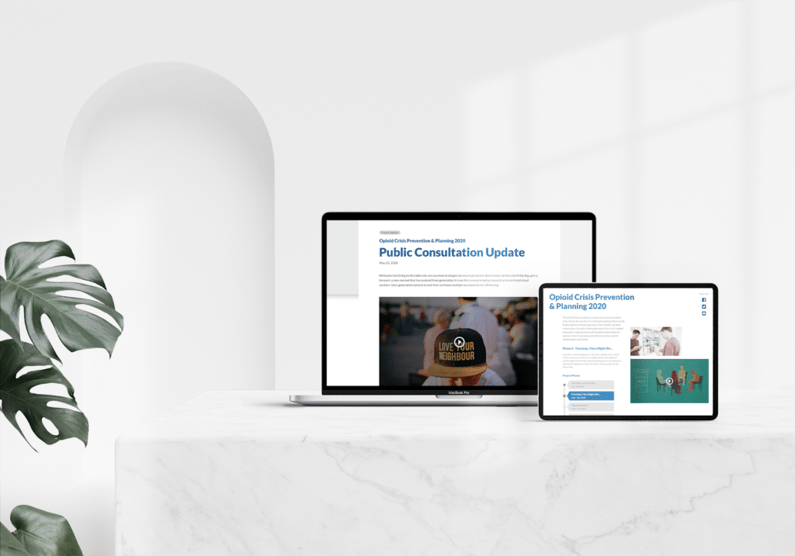Digital Engagement: Meet Them Where They Are
.png)
Zencity
The Platform for Community Trust
True Engagement is a Hybrid
The shift to digital isn’t new, and we’re not here to tell you that physical is gone. The reality of modern community engagement is definitively hybrid, and the possibilities available to reach different segments of your communities have never been greater.
When considering engagement as a hybrid activity, the intention is not to draw a distinct binary between those attending town halls and those participating in surveys and online projects. Instead, it’s a means of acknowledging the complex nature of your audiences. Some reside firmly at either end of the spectrum, and many participate, relate, and engage.
There’s an undeniably distinct advantage in conversation and listening, both are made transparent and accessible in physical engagement. In-person connection is vital for public engagement and ideation, but it represents distinct moments and presents barriers like location and time. As valuable as these moments are, the barriers limit the reach and meaningfulness of the engagements.
The value of hybrid connection is that you maintain a continued public presence, providing recurring and continuous pathways for your community to connect with project change, advancement, and ideation. This pattern ensures that you engage throughout the process and that your diverse audiences can easily engage.
Some members of your community will attend in-person meetings and still supplement that participation with digital engagement. Others will engage purely through your digital services. In either form, digital plays a crucial role in providing continuity—your community should always have a way to participate, regardless of barriers. For those who engage purely through digital means, their experience should be equal—or better—than the experience of those who participate in person.

Accessibility as a Practice
Just as a town hall meeting must provide accessible options for attendance, participation, and accommodation, your engagements' digital counterparts must be freely accessible by your users.
When you think of accessibility, the first thing that comes to mind is likely compliance: ensuring that your digital platform is WCAG, ADA, and 508-ready. The reality is that compliance is the floor, not the ceiling.
Approaching digital design through accessibility standards goes far beyond checking boxes; behind each compliance, statute sit substantial portions of the population and your audience.
Specifically, 18.7% of the U.S. population has some form of documented disability, breaking down into the following categories (accounting for overlap):
19.9 million (8.2%)
report difficulty lifting or grasping objects, including mice and keyboards
15.2 million (6.3%)
report a cognitive, mental, or emotional impairment
8.1 million (3.3%)
report a meaningful vision impairment, ranging from screen-reader reliance to substantial color blindness
7.6 million (3.1%)
report a hearing impairment, relying on captions and transcripts of digital media
Before digging deeper, we can already say that if your engagement is not meeting accessibility standards, “you are potentially excluding 20% of the population from the conversation on your site.”
Thinking of these numbers and their impact along a digital product lifecycle, the World Bank and World Health Organization note that nearly “every time new technology is introduced, people with disabilities do not obtain the full benefit.”
With digital engagements, accessibility compliance is a must, but accurate compliance goes beyond the interface requirements. Your communities represent varied, ranging needs and segments: for some, an accessible engagement leverages interaction design over text entry; for others, it means being able to work through a survey with their thumb, phone in one hand, while riding the bus. Accessibility can mean contextual access to information to participate, and it can also mean prioritizing privacy or anonymity for vulnerable populations.
Providing the space for meaningful collaboration with your communities means a commitment to equipping your users with the materials they need, both in terms of the context required to participate and the tools to engage effectively.
A Commitment to Context
Traditional in-person engagement relies on a combination of assumed context and available artifacts: attendees are usually expected to be relatively informed, interested, and have relevant literature. Digital engagements, however, enable you to leverage convenient, contextual information delivery as part of the user journey.
At the most basic level, this means that the digital components of your engagements give audiences the same contextual information they would expect to receive in person. At a deeper level of alignment, the continuity provided by ongoing digital engagement throughout the decision-making process ensures a reliable, consistent, trusted space to return to for context, information, and results.
While the requirements of what sort of content and media best serve your communities will vary by engagement, there are several fundamental principles to shape the foundations of your digital projects:
Consolidate Content: keep your audiences up-to-date by providing a consistent, central hub of information and contextual content. Ensure that they have a known place to return to.
Visualize the Process: leverage timelines and contextual media to visualize the decision-making process around your engagements.
Provide Launchpads: Create consistent launch points that align with your contextual content. This will enable your users to see and participate in active engagements and to see reporting on past engagements, all in a central place.

Tools for Diverse Engagement
Each specific engagement represents a library of unique context, consequences, audiences, and processes. To give your communities a meaningfully representative experience, you need to approach engagement design from the perspective of diversity of access.
Your engagement can create intentional user journeys with the proper contexts that provide relevant questions to the right audiences. In-person engagement and collaboration activities empower your audiences to speak up when it matters and keep the choice to engage solely on their own. The digital components of your engagements need to provide that same measure of choice and can even augment the experience with the right tooling.

Within these branching pathways, your digital engagements can present participants with a wide range of question types optimized for varied means of engagement:
Skip logic: questions served to a participant should change based on how they responded to the previous question, allowing for branching pathways that provide intuitive user journeys for participants to engage in relevant feedback.
Qualitative questions: these allow participants to express themselves through long-form answers.
Quantitative questions: these allow you to collect or verify public mandate through single-select, multi-select, custom scale (matrix), or forced-ranking question styles.
Image variant questions: Both forced-rank and multiple-choice style questions allow you to include images in the questions, enabling you to provide participants with additional visual context designed to increase the quality of understanding and feedback.
Geospatial and image annotation questions: Both question types allow participants to interact with an image (or a map) and leave interactive feedback in the form of annotations.
Budgeting questions: this question type forces a participant to explore trade-offs and gather input within the limitations by selecting options to add up to predetermined totals.
You’re Making a Promise
You're making a promise when you reach out to inform, gather feedback, or start a conversation. You’re stating that the ideas, opinions, and feedback you receive will be synthesized into the project and affect the outcome somehow. You’re making a promise of collaboration and transparency. Each form and type of engagement represents a different promise, ranging from a commitment to inform to an agreement to incorporate suggestions. Each type of promise is valid and plays a role, but it’s crucial that you recognize the level of your commitment and live up to it.
When it comes to the digital space, delivering on your promise of collaboration and transparency requires intentionality in terms of the accessibility of the engagement and how you involve your community in the process.
To sum it up in a phrase:
The success of your engagement is about meeting your audiences where they are.
For many of your community members, that’s in the digital arena—in the interstitial moments of a day, on mobile devices and laptops. We designed Zencity Engage (Formerly Civil Space) to help you fulfill this promise effectively: digital engagements create space for continuous collaboration, providing diverse ways for your audiences to participate.
Digital community engagement spans community panels, participatory forums, and context-driven engagement activities designed to ask and prompt more profound questions about topical issues. In each case, the unique suite of activities and methods focuses on empowering your communities to participate in decision-making.
%20copy-1.png?width=544&height=120&name=Logo_black%20(1)%20copy-1.png)



